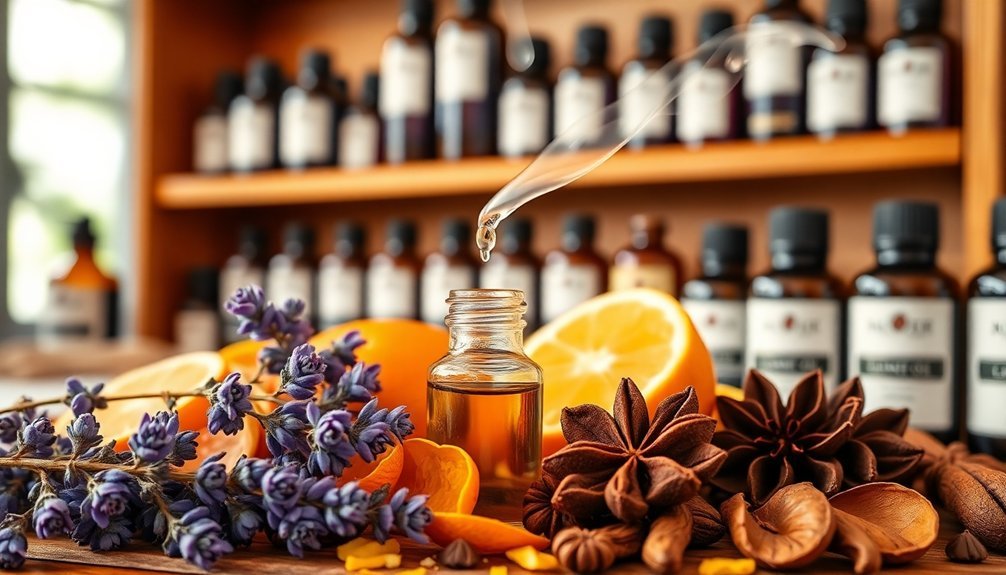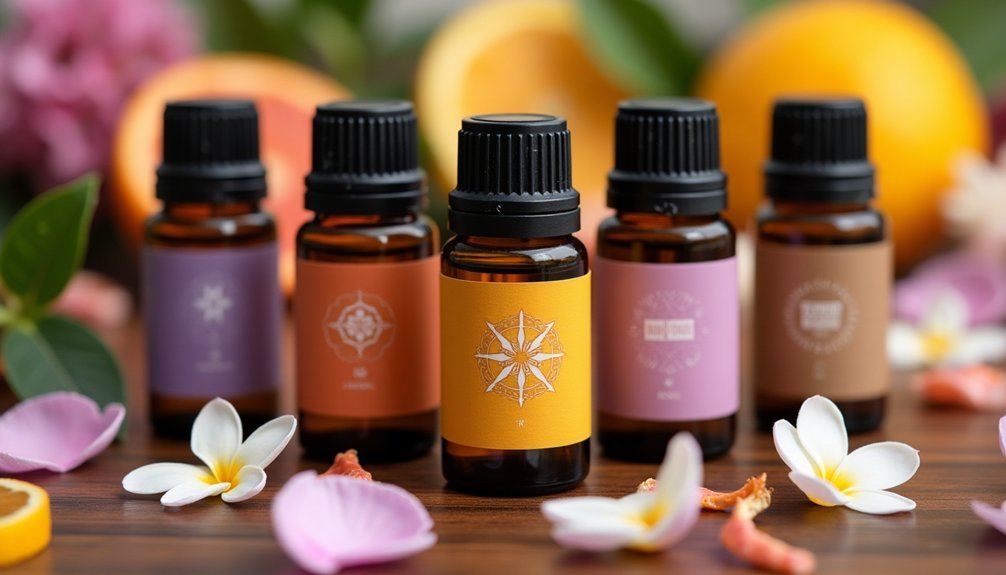Master your scent pyramid's balance by starting with a 30-60-10 ratio as your foundation, though you'll want to adjust these proportions based on your fragrance style. Focus on creating seamless shifts between layers by selecting notes that naturally complement each other, like bergamot to rose or jasmine to amber. When selecting compatible notes, guarantee your top notes are light and volatile while your base provides lasting depth. The art of perfect pyramids unfolds with each careful blend.
Mastering The 30-60-10 Ratio For Balanced Scent Pyramids

While many perfume enthusiasts have heard of the 30-60-10 ratio for creating scent pyramids, this widely circulated formula isn't a universal rule for fragrance creation.
Different types of perfumes require varying proportions of notes to achieve their intended effects.
You'll find that fresh, citrusy fragrances might need a higher percentage of top notes, while warm, oriental scents could demand more base notes for depth. Just as interior designers use color balance principles to create harmonious spaces, perfumers must consider the balance of scent notes carefully.
Don't let fixed ratios limit your creativity – instead, let your nose guide you through the blending process.
Consider how your top notes, like grapefruit or peppermint, will interact with heart notes such as rose or jasmine, and how they'll settle into base notes like vanilla or sandalwood.
Each fragrance tells its own story, and the proportions should reflect the unique character you're aiming to create.
Creating Seamless Transitions Between Notes
Moving beyond fixed ratios, the true artistry of perfume creation lies in how each note flows naturally into the next. You'll want to focus on selecting ingredients that complement each other while maintaining distinct character shifts throughout the fragrance's lifecycle. The harmonious interaction between notes is essential for creating a well-balanced perfume that evolves gracefully on the skin.
| Note Level | Common Pairings |
|---|---|
| Top → Middle | Bergamot → Rose |
| Middle → Base | Jasmine → Amber |
| Top → Base | Citrus → Vanilla |
To achieve seamless shifts, establish your top notes gradually fade rather than disappear abruptly. Choose middle notes that share subtle characteristics with both your top and base selections. For example, if you're using citrus top notes and woody base notes, consider floral-woody middle notes like ylang-ylang. This creates a bridge between the bright opening and deep foundation, establishing your fragrance tells a cohesive olfactory story.
Selecting Compatible Notes Within Each Layer

Creating harmonious fragrances requires careful selection of compatible notes within each layer of the scent pyramid.
When selecting top notes, you'll want to focus on light, volatile elements like citrus and herbs that work together to create an inviting first impression.
For your middle notes, combine complementary florals and spices that enhance each other, such as rose with lavender or jasmine with cinnamon. The middle notes function as the heart of fragrance, providing the main character and lasting several hours on the skin.
Your base notes should feature deep, lasting scents that provide a solid foundation. Try pairing vanilla with sandalwood or musk with patchouli.
Keep in mind the proportions for a balanced blend: 20-40% top notes, 50-75% middle notes, and 5-10% base notes.
Use the drop-by-drop method to fine-tune your combinations until you achieve the perfect harmony within each layer.
Frequently Asked Questions
How Long Should I Wait Between Applying Different Fragrance Layers?
You'll want to wait 3-5 minutes between each fragrance layer. Start with your strongest scent, let it settle, then add lighter ones. Don't rush – proper absorption guarantees your scents won't mix poorly.
Can Weather Conditions Affect How My Fragrance Pyramid Develops?
Yes, weather dramatically affects your fragrance pyramid. In heat, top notes evaporate faster while cold slows development. High humidity enhances heart notes, and dry conditions emphasize base notes while shortening overall longevity.
Should I Layer Fragrances on Dry or Moisturized Skin?
You'll get better results applying fragrances to moisturized skin. It helps scents last longer since fragrance molecules cling better to hydrated skin. Always moisturize after showering before layering your favorite scents.
Do Synthetic and Natural Ingredients Blend Differently in Fragrance Pyramids?
Yes, they blend differently. You'll find synthetics offer more stability and predictable behavior, while natural ingredients bring complexity but evaporate faster. They work together to create balanced fragrances with both lasting power and depth.
How Can I Test My Fragrance Blend Without Applying It Directly?
You can test your fragrance blend using smelling strips, small wax melts, or reed diffusers. Each method lets you safely evaluate the scent's performance and development without direct skin contact.
In Summary
You're now equipped with three essential techniques for crafting flawless scent pyramids. By following the 30-60-10 ratio, ensuring smooth shifts between layers, and choosing harmonious notes, you'll create well-balanced fragrances that tell a compelling olfactory story. Remember to experiment and trust your nose – while these guidelines provide structure, your unique creative instincts will help you develop signature scent combinations that stand out.





Leave a Reply